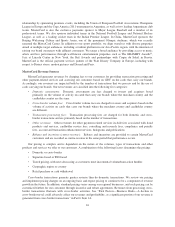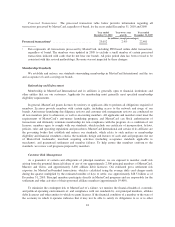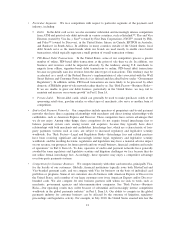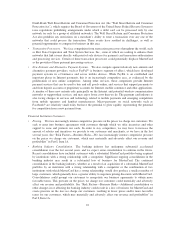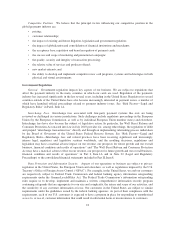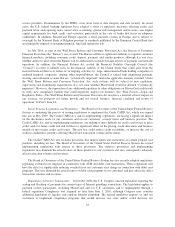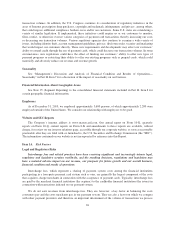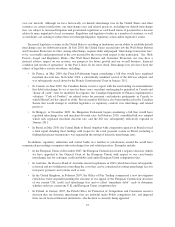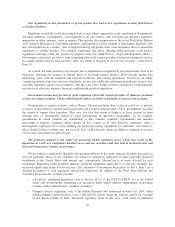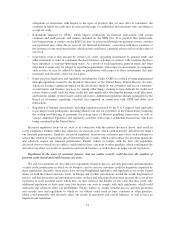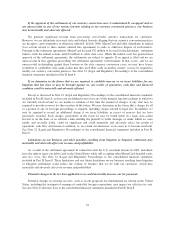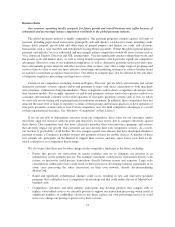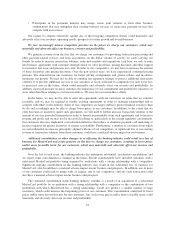MasterCard 2010 Annual Report Download - page 36
Download and view the complete annual report
Please find page 36 of the 2010 MasterCard annual report below. You can navigate through the pages in the report by either clicking on the pages listed below, or by using the keyword search tool below to find specific information within the annual report.transaction volumes. In addition, the U.S. Congress continues its consideration of regulatory initiatives in the
areas of Internet prescription drug purchases, copyright and trademark infringement, and privacy, among others,
that could impose additional compliance burdens on us and/or our customers. Some U.S. states are considering a
variety of similar legislation. If implemented, these initiatives could require us or our customers to monitor,
filter, restrict, or otherwise oversee various categories of payment card transactions, thereby increasing our costs
or decreasing our transaction volumes. Various regulatory agencies also continue to examine a wide variety of
issues, including identity theft, account management guidelines, privacy, disclosure rules, security and marketing
that would impact our customers directly. These new requirements and developments may affect our customers’
ability to extend credit through the use of payment cards, which could decrease our transaction volumes. In some
circumstances, new regulations could have the effect of limiting our customers’ ability to offer new types of
payment programs or restricting their ability to offer our existing programs such as prepaid cards, which could
materially and adversely reduce our revenue and revenue growth.
Seasonality
See “Management’s Discussion and Analysis of Financial Condition and Results of Operations—
Seasonality” in Part II, Item 7 for a discussion of the impact of seasonality on our business.
Financial Information About Geographic Areas
See Note 25 (Segment Reporting) to the consolidated financial statements included in Part II, Item 8 for
certain geographic financial information.
Employees
As of December 31, 2010, we employed approximately 5,600 persons, of which approximately 2,200 were
employed outside of the United States. We consider our relationship with employees to be good.
Website and SEC Reports
The Company’s internet address is www.mastercard.com. Our annual report on Form 10-K, quarterly
reports on Form 10-Q, current reports on Form 8-K and amendments to those reports are available, without
charge, for review on our investor relations page, accessible through our corporate website, as soon as reasonably
practicable after they are filed with, or furnished to, the U.S. Securities and Exchange Commission (the “SEC”).
The information contained on our website is not incorporated by reference into this Report.
Item 1A. Risk Factors
Legal and Regulatory Risks
Interchange fees and related practices have been receiving significant and increasingly intense legal,
regulatory and legislative scrutiny worldwide, and the resulting decisions, regulations and legislation may
have a material adverse impact on our revenue, our prospects for future growth and our overall business,
financial condition and results of operations.
Interchange fees, which represent a sharing of payment system costs among the financial institutions
participating in a four-party payment card system such as ours, are generally the largest component of the costs
that acquirers charge merchants in connection with the acceptance of payment cards. Typically, interchange fees
are paid by the merchant financial institution (the acquirer) to the cardholder financial institution (the issuer) in
connection with transactions initiated on our payment system.
We do not earn revenues from interchange fees. They are, however, a key factor in balancing the costs
consumers pay and the costs merchants pay in our payment system. They are also a factor on which we compete
with other payment providers and therefore an important determinant of the volume of transactions we process
26


